في هذه المقالة، سنتعرف في هذه المقالة على أصحاب المصلحة في إدارة المشاريع ، أنواع أصحاب المصلحة في المشروع وأمثلة وكيفية تحليلها. سنتعلم أيضًا الطريقة الأكثر فعالية لتنفيذ إدارة أصحاب المصلحة في المشروع.
حسنًا، دعنا نتعرف على كل شيء عن أصحاب المصلحة في المشروع. 🔍
ما هو صاحب المصلحة في المشروع؟
صاحب المصلحة في المشروع هو فرد أو منظمة أو مجموعة تقوم بدور نشط أو مهتم بأنشطة المشروع، ولها تأثير محتمل على المشروع المنجزات و/أو بيئة المشروع، ويتأثر بنتائج المشروع أو يكون قريبًا من الآخرين الذين قد يتأثرون بالمشروع.
في الأساس، أصحاب المصلحة هم الأشخاص أو المجموعات التي لديها ما تكسبه (أو تخسره) من المشروع. معهد إدارة المشاريع يعرّف أصحاب المصلحة في المشروع بأنهم "الأفراد والمنظمات الذين يشاركون بنشاط في المشروع، أو الذين قد تتأثر مصالحهم إيجابًا أو سلبًا نتيجة تنفيذ المشروع أو إكمال المشروع بنجاح."
لذلك إذا كان أداء المشروع جيداً، فإن أصحاب المصلحة سيستفيدون منه.
أما إذا انحدر المشروع، فإن أصحاب المصلحة ينحدرون معه أيضاً ... 😅
من هم أصحاب المصلحة في المشروع؟
يمكنك تصنيف أصحاب المصلحة في إدارة المشاريع إلى نوعين داخلي و خارجي أصحاب المصلحة.
ويعتمد هذان النوعان من أصحاب المصلحة في إدارة المشاريع على علاقة أصحاب المصلحة بالمنظمة:
أصحاب المصلحة الداخليين
كما يوحي الاسم، فإن أصحاب المصلحة الداخليين هم من داخل المنظمة أو الشركة، وهم يركزون على مخاطر المشروع، ويشاركون بشكل مباشر في جميع مراحل عملية المشروع. وعادةً ما يمتلك أعضاء فريق الشركة هؤلاء معرفة عميقة بجمهورهم وعملائهم والشركة، وغالبًا ما يُنظر إليهم على أنهم أصحاب المصلحة، وغالبًا ما يشغلون مناصب قيادية رفيعة المستوى يعملون مباشرةً مع مختلف مستويات العمليات لتحقيق النتائج المرجوة.
وبصفتك مدير مشروع، إليك بعضًا من أصحاب المصلحة الداخليين الشائعين الذين قد تتعامل معهم:
- راعي المشروع
- مستثمر المشروع
- مدير المشروع
- أعضاء فريق المشروع
أصحاب المصلحة الخارجيين
من ناحية أخرى، لا ينتمي أصحاب المصلحة الخارجيون إلى مؤسستك أو عملك. أصحاب المصلحة في إدارة المشروع هؤلاء هم أطراف خارجية، مثل العملاء أو المستخدمين النهائيين. وبعبارة أخرى، تقع على عاتقك مسؤولية إدارة هذه الاتصالات مع أصحاب المصلحة الأساسيين والعملاء الخارجيين، مع الحفاظ على خصوصية المعلومات الهامة حتى يكون من الضروري تحديدها لجميع الأطراف.
إن تلبية توقعات الأنواع المختلفة من أصحاب المصلحة المؤثرين، وإطلاعهم على كل ما يتعلق بالمشروع، وإبقاء أصحاب المصلحة المختلفين على اطلاع، هو نصف خطة إدارة أصحاب المصلحة. ولكن كمديرين للمشروع، يجب أن تكون قادرًا أولاً على تسمية أصحاب المصلحة هؤلاء، وكذلك فهم احتياجات رعاة المشروع. أهم شيء يجب أن تتذكره هو توصيل نطاق المشروع بوضوح و إدارة توقعات أصحاب المصلحة وأحيانًا قوائم طويلة من المطالب من القيادة
هذا رائع. ولكن من هم أصحاب المصلحة في المشروع؟ بصفتك مدير المشروع، من المهم أن تحدد أصحاب المصلحة في المشروع منذ البداية وتواصل التركيز على تنفيذ المشروع. قد يكون مديرو الموارد والمديرون الوظيفيون وغيرهم من الإدارة العليا أكثر تركيزًا على مرحلة المشروع وتخطيط دورة حياة المشروع، في حين أن أصحاب المصلحة الداعمين يتعاملون مع جميع أعضاء فريق المشروع كما لو كانوا على نفس المستوى ويحبون البقاء على اطلاع دائم على تقدم المشروع وكذلك ملاحظات العملاء.
فيما يلي بعض أصحاب المصلحة الخارجيين الشائعين:
- البائع
- المورد
- العميل
- المقاولون من الباطن
كيف تقوم بتحليل أصحاب المصلحة؟ تحليل أصحاب المصلحة أو كما يسميه البعض تخطيط أصحاب المصلحة، مهم لأنه
- يبني الثقة مع أصحاب المصلحة
- يحدد شكلخطط المشروع ويحافظ على الشفافية
- يزيد من فرصنجاح المشروع إن أفضل طريق لنجاح المشروع هو تحديد توقعات المشروع بوضوح لأصحاب المصلحة المعنيين، وتحديد المخاطر، وتقديم الملاحظات لإدارة أصحاب المصلحة في المشروع و
بناء فريق قوي يحتوي على أصحاب المصلحة الرئيسيين في المشروع هو السبيل الوحيد لنجاح المشروع.
مثال على مخطط سياق تحليل أصحاب المصلحة:
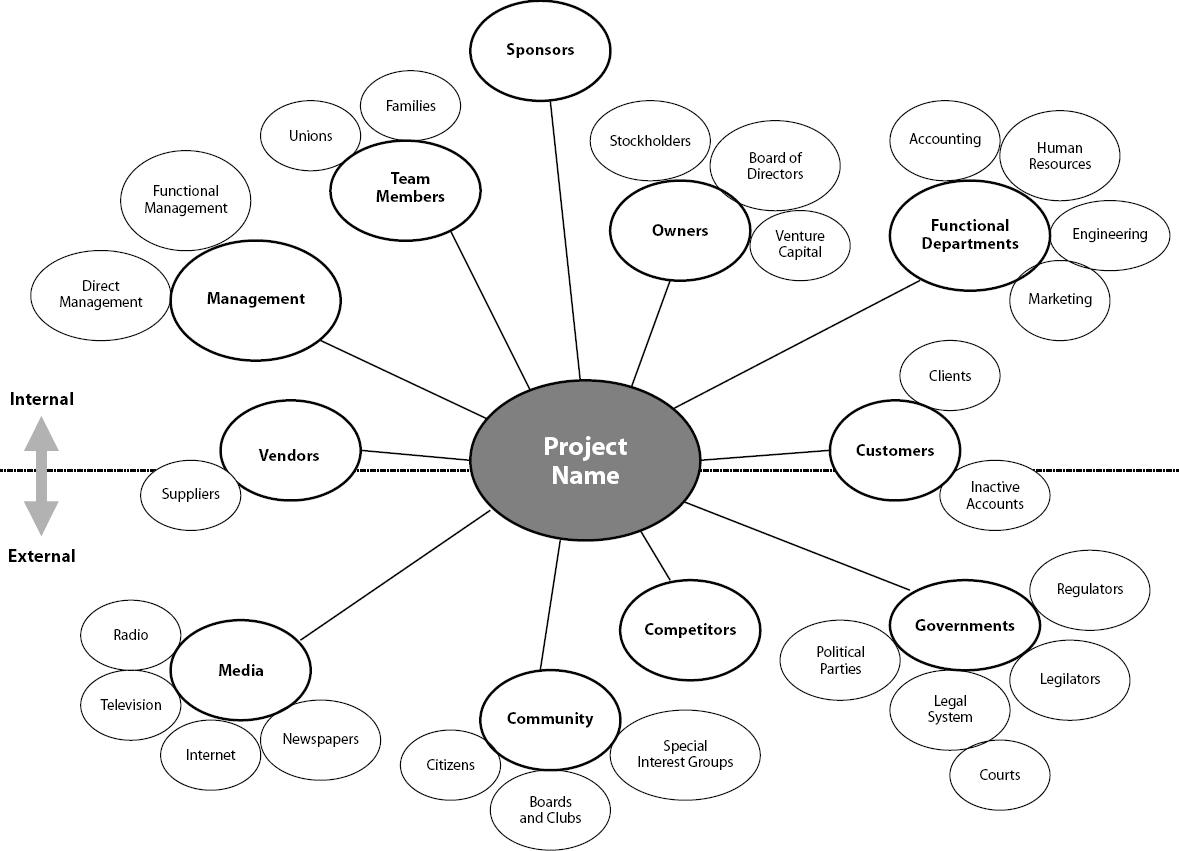
المصدر: pmi.org بالإضافة إلى ذلك، إن تحديد الأنماط في مشاركة أصحاب المصلحة سيساعدك على تجنب التأثير السلبي لأصحاب المصلحة في المستقبل. قد يكون لأصحاب المصلحة ذوي الاهتمام العالي والتأثير الكبير والمالكين والمديرين الآخرين من الفرق الأخرى و/أو الأقسام الأخرى أجندات خفية أو ببساطة قد لا يكونون على نفس الصفحة التي تتفق عليها أنت وفريقك.
سواء كان ذلك إيجابيًا أو سلبيًا، من المهم أن تفعل كل ما بوسعك لضمان توصيل الأفكار والخطوط العريضة والمعلومات العامة وأن المستثمرين وأصحاب المصلحة الرئيسيين راضون عن الجداول الزمنية للمشروع والعمليات وشركة أعضاء الفريق.
دعنا نقسم تحليل أصحاب المصلحة إلى ثلاث خطوات:
1. تحديد أصحاب المصلحة المحتملين
الخطوة الأولى هي تحديد أصحاب المصلحة.
يجب عليك تحديد كل من أصحاب المصلحة الداخليين والخارجيين.
وأحياناً يكون الأمر واضحاً جداً.
بالطبع، يعتبر العميل SPOC وأعضاء فريق المشروع من أصحاب المصلحة الرئيسيين.
ولكن هل هناك ما هو أكثر من ذلك؟
لهذا، ستحتاج إلى ما يلي ميثاق المشروع وغيرها وثائق المشروع المهمة . قبل بدء المشروع، يجب إنشاء ميثاق المشروع وتقديمه إلى جميع أصحاب المصلحة هؤلاء. يجب إبلاغ أصحاب المصلحة المهمين بأي مخاطر محتملة، بما في ذلك العوامل البيئية، التي قد تؤثر على نتائج المشروع.
يمكن أن يستغرق تحديد بعض أصحاب المصلحة الصعبين ساعات من جلسات العصف الذهني ومراجعة الوثائق.
وينبغي أن تساعدك البيانات التي تجمعها من هذه العناصر على حصر جميع أصحاب المصلحة.
يمكنك البدء في هذا التحليل باستخدام أعلى إنتاجية و أدوات إدارة المشاريع في العالم؛ دعنا نوضح لك كيف!
قل مرحبًا إلى ClickUp .
يمكنك استخدام مستندات ClickUp لإنشاء قائمة أصحاب المصلحة الخاصة بك مع تحرير النص الغني، بما في ذلك اللافتات والعناوين والخطوط وما إلى ذلك...أي شيء مهم!
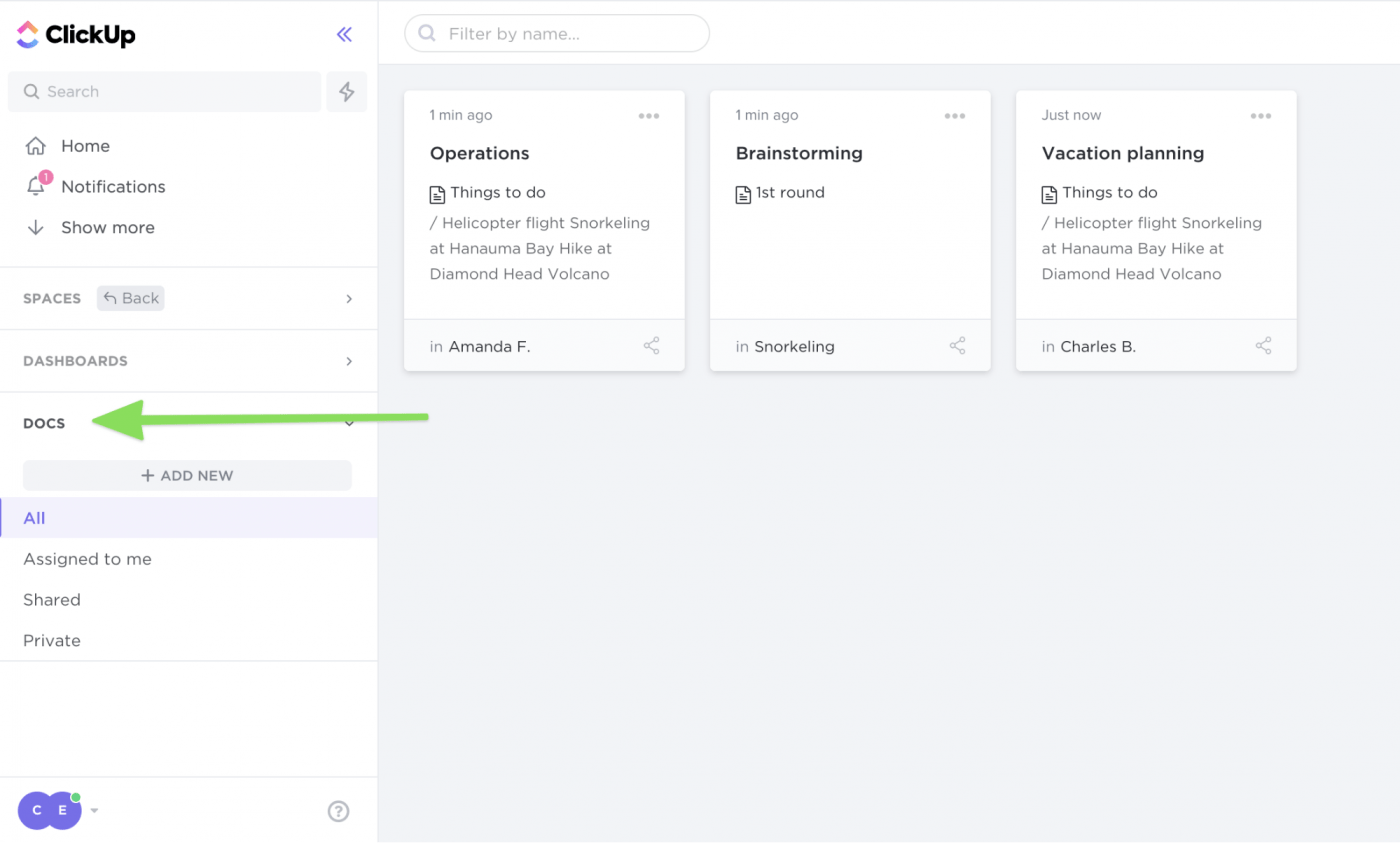
المستندات مرتبة حسب الفئة: الكل، والمخصص لي، والمشتركة، والخاصة
استخدم وظائف الفهرسة ووظائف الويكي المحسّنة في المستندات للوصول إلى كل جزء من وثائق المشروع. ابحث حسب الكلمة أو العبارة واعثر على أسماء جميع أصحاب المصلحة لديك!
أفضل جزء هو أنه يمكنك تقسيم عملية ' تحديد أصحاب المصلحة بالكامل ' بين أعضاء فريق مشروعك.
يمكنكم جميعًا الاستمرار في تحديد أصحاب المصلحة وإضافتهم إلى ملف المستندات في الوقت الفعلي وإنشاء سجل أصحاب المصلحة في المشروع.
سيحتوي سجل أصحاب المصلحة في المشروع على جميع أسماء وأدوار وسلطة واهتمامات أصحاب المصلحة المختلفين. تعاون الفريق !
2. معرفة كيفية تحديد أولويات أصحاب المصلحة كمدير مشروع
ينص معهد إدارة المشاريع (PMI) على أنه "لكي يتم تصنيفه كأحد أصحاب المصلحة، يجب أن يكون للشخص أو المجموعة بعض الاهتمام أو مستوى من التأثير الذي يمكن أن يؤثر على المشروع."
ليس كل أصحاب المصلحة المحددين متساوين في المشروع.
فبعضهم أكثر أهمية بسبب تأثيرهم.
لذا فإن الخطوة الثانية هي تحديد أولويات أصحاب المصلحة.
إليك بعض الأسئلة لمساعدة فريق مشروعك على التمييز بين أصحاب المصلحة الأساسيين وأصحاب المصلحة الثانويين:
- هل يشاركونك رؤيتك حول أهداف المشروع الأساسية؟
- هل يمكنهم المساهمة بشكل كبير في قدرتك في شكل أموال ومعلومات ونطاق المشروع وما إلى ذلك؟
- هل يصعب أو يستحيل استبدالهم؟
إذا كانت الإجابة على هذه الأسئلة بـ "نعم"، فهم أصحاب المصلحة الأساسيين.
يجب أن تساعدك قائمة أصحاب المصلحة الأساسيين والثانويين على إنشاء خريطة ذهنية لأصحاب المصلحة .
لذلك، ستحتاج إلى انقر فوق الخرائط الذهنية .
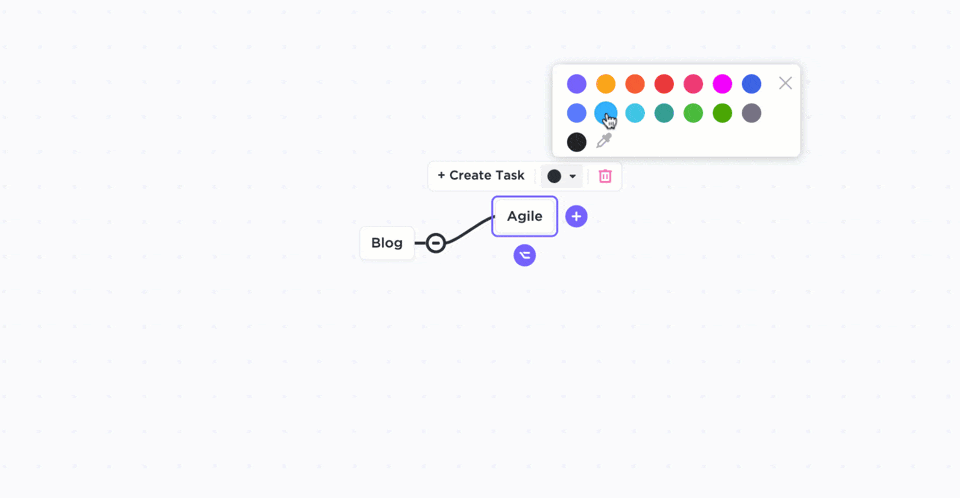
قم بإنشاء أي عدد تريده من العقد للنقاط المرجعية في ClickUp Mind Maps
ارسم أصحاب المصلحة باستخدام الوضع الفارغ لتصور جميع الأشخاص الذين يمكن أن يؤثروا على مشروعك أو كيفية ارتباطهم.
3. إشراك أصحاب المصلحة
الآن بعد أن تعرفت على كل أصحاب المصلحة المهمين ومن يجب تحديد أولوياتهم، حان الوقت لإشراك أصحاب المصلحة.
على عكس الخطوات السابقة، فإن إشراك أصحاب المصلحة هو عملية مستمرة طوال فترة مشروعك. تحتاج إلى تحديد توقعات أصحاب المصلحة ومعالجة مخاوفهم.
و ClickUp هنا لمساعدتك في كل خطوة على الطريق.
## كيفية إدارة أصحاب المصلحة في المشروع
تتمحور إدارة توقعات أصحاب المصلحة في الغالب حول إسعادهم.
فهم بحاجة إلى المعلومات من خلال التواصل الشفاف مع أصحاب المصلحة.
وسنساعدك على بناء عملية إدارة أصحاب المصلحة حول هذا الأمر.
1. اعرض عليهم خطة مشروعك
فكر في صاحب المصلحة كضيف في مطعمك.
ما هو أول شيء تفعله؟ أرهم ما هو موجود في قائمة الطعام اليوم.
وبالمثل، يجب أن تبدأ إدارة أصحاب المصلحة بأن تعرض عليهم ما هو موجود على قائمة الطعام اليوم خطة المشروع تحتوي على
- أهداف المشروع
- أهداف المشروع
- الجدول الزمني للمشروع
خاص اليوم؟ التواصل!
ولكن أولاً، يجب عليك إنشاء خطة مشروع. مخطط جانت الخاص بـ ClickUp مثالي لتخطيط المشاريع، ولا يستغرق إنشاؤه سوى ثلاث خطوات بسيطة.
- انقر على علامة + في أي مساحة، أو قائمة، أو مجلد
- اختر جانت
- قم بتسميته
هذا كل شيء. لقد حصلت لنفسك على مخطط جانت جميل.
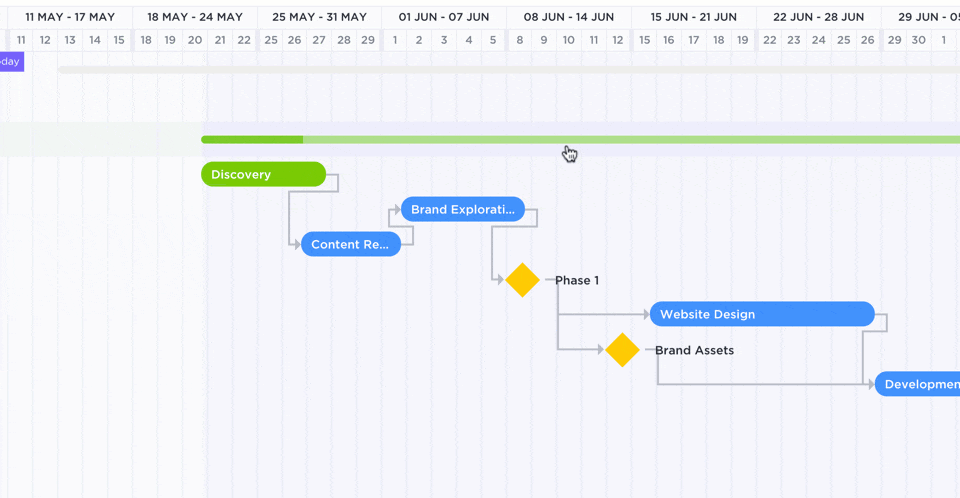
إعادة تعيين جميع تواريخ بدء المهام المتضمنة وتواريخ استحقاقها
2. قم بإعداد خطة تواصل للمواءمة والتوضيح وخلق حالة من النجاح والإيجابية حيث يمكن للجميع التعاون كفريق واحد.
بالنسبة لأصحاب المصلحة الرئيسيين، تتمحور إدارة المشروع حول تلك التحديثات في الوقت المناسب.
عليك أن تُبقي كل مجموعة من أصحاب المصلحة والأفراد على اطلاع، وهذا يتطلب خطة تواصل.
هل سيكون ذلك عبر رسائل البريد الإلكتروني, اجتماعات الانطلاق ومؤتمرات الفيديو ومكالمات الموز؟
مثل عرض الدردشة في ClickUp . يمكنك التحدث عن أي شيء وكل شيء دون مغادرة منصة إدارة المشروع.
_أليس هذا مريحاً؟
لن تضطر إلى إضاعة الوقت في التبديل بين التطبيقات أو حتى علامات التبويب للتواصل.
إضافة الضيوف (أصحاب المصلحة الخارجيين) إلى دردشاتك وتحديد ما إذا كان بإمكانهم إنشاء طريقة عرض دردشة أم لا.
هل الدردشة ليست من اختصاصك؟
استضف اجتماعات Zoom وانضم إليها مباشرةً من ClickUp، وذلك بفضل تكامل Zoom .
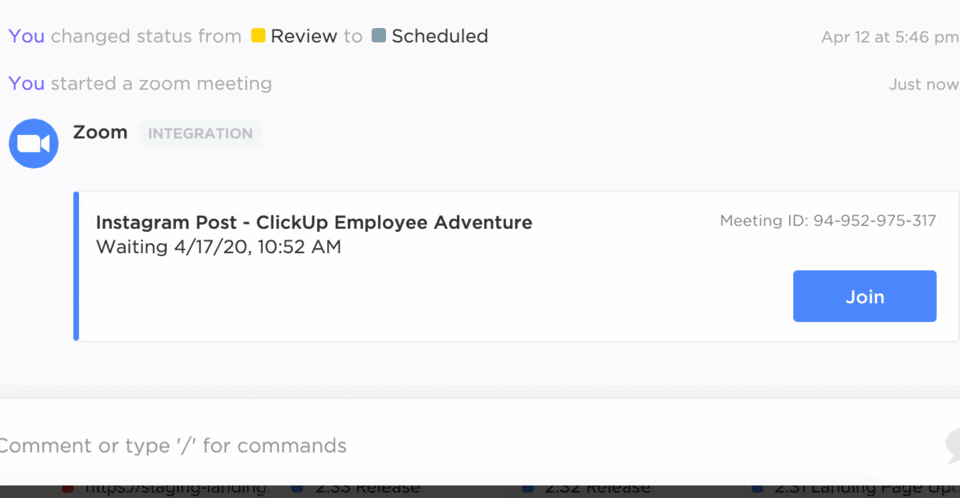
ابدأ اجتماع Zoom مباشرةً من مهمة ClickUp
وإذا كنت أحد هؤلاء الأشخاص الذين لا يستطيعون التخلي عن رسائل البريد الإلكتروني، فلدينا حل لك أيضاً.
يمكنك إرسال واستقبال رسائل البريد الإلكتروني مباشرة من ClickUp باستخدام البريد الإلكتروني ClickApp .
بالحديث عن رسائل البريد الإلكتروني، إذا كنت بحاجة إلى إرسال أي مستندات أو عقود قانونية تحتاج إلى بعض التعديلات، فلن تضطر إلى البحث في مكان آخر.
توفر ميزات التدقيق لدينا شرح PDF كذلك
3. مشاركة توزيع عبء العمل
تُعد مشاركة توزيع عبء العمل الخاص بك جزءًا مهمًا من خطة إدارة أصحاب المصلحة لأنه يوضح لهم:
- يمكن تحقيق أهداف مشروعك
- أنت تعرف ما تقوم به
- لديك الموارد المناسبة
إذاً، أظهر لأصحاب المصلحة ما تعمل عليه مع عرض عبء العمل .
وفويلا!
لن يتم ترك أصحاب المصلحة في الظلام بعد الآن.
وعلاوة على ذلك، ستتمكن من توفير المزيد من الوقت أو الموارد أو الخبرة بناءً على توزيع عبء العمل.
4. السماح للقيادة وأصحاب المصلحة الرئيسيين بعرض المسؤوليات واكتساب الرؤى
_من الذي لا يحب أن يرى الإبرة تتحرك؟ قادة المشروع وغيرهم من أصحاب المصلحة المعنيين مهتمون دائمًا بتقدم المشروع، وخاصة المشاركة في إكماله بنجاح.
يرغب أصحاب المصلحة في مشروعك في معرفة مدى جودة أداء المشروع ومدى ابتعاده عن خط النهاية. وما هو أفضل من لوحة معلومات المشروع لتزويدك أنت وأصحاب المصلحة برؤية ثاقبة لتقدم المشروع.
الخطوة الأولى هي تجربة ClickUp Dashboards بدلاً من ذلك
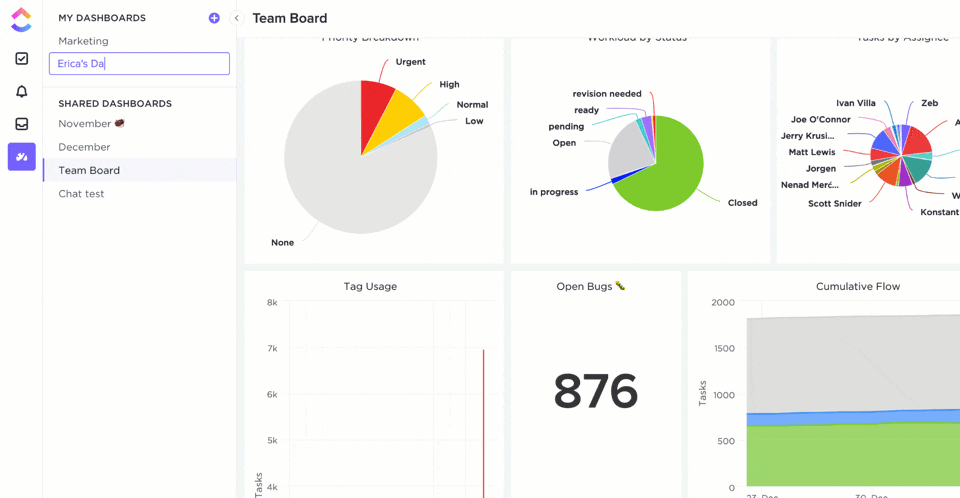
استخدم عناصر واجهة مستخدم قابلة للتخصيص لبناء مركز التحكم في مهمتك في لوحات معلومات ClickUp Dashboards
لجلب رؤى المشروع إلى لوحة التحكم، يمكنك إضافة أدوات مثل:
- سباقات السرعة
- تتبع الوقت
- الأولويات
- مخصص
- الحالات
والمزيد!
توفر لك أدوات ClickUp's Sprint Widgets المفيدة التالية مخططات إدارة المشاريع لتصور تقدم مشروعك
- مخطط السرعة :: تصور معدل إنجاز مهام المشروع وتحديد سعة العمل لسباقات السرعة المستقبلية
- مخطط التدفق التراكمي : عرض التقدم المحرز في حالة مهامك مع مرور الوقت واكتشاف الاختناقات
- مخطط الاحتراق : تصور عملك المكتمل وإجمالي عمل المشروع
- الرسم البياني التنازلي : تتبع مقدار العمل المتبقي والوقت المتبقي لإنجاز العمل
لأصحاب المصلحة الداخليين، مشاركة الوصول للعرض أو التعديل باستخدام الأذونات .
قم بالرد على المكالمة
بالنسبة لأصحاب المصلحة الخارجيين، يمكنك دائمًا تصدير البيانات من لوحات المعلومات الأدوات بتنسيقات متعددة، بما في ذلك PDF وJPEG وCSV وغيرها.
إدارة كاملة لأصحاب المصلحة تحت سقف واحد
يمكن أن يؤدي تأثير أصحاب المصلحة إلى تحقيق نتائج مشروعك أو إفشاله. كما يمكن أن يكون هذا التأثير إيجابياً أو سلبياً على العلاقات مع أصحاب المصلحة.
هذا هو مدى قوتها.
عليك أن تلبي احتياجات أصحاب المصلحة، وتبقيهم على اطلاع، وتضع في اعتبارك اللاعبين الرئيسيين الآخرين في جميع المؤسسات.
والطريقة الوحيدة للقيام بكل ذلك هي من خلال استراتيجية قوية لإدارة أصحاب المصلحة وأداة قوية لإدارة المشاريع.
وهنا يأتي دور ClickUp.
إنها أداة شاملة لإدارة مهام المشروع وتعيينها وتتبع الوقت وحتى إدارة أصحاب المصلحة في المشروع! احصل على ClickUp مجاناً اليوم حتى تتمكن أنت وأصحاب المصلحة لديك من إنتاج مشروع ناجح تلو الآخر!

